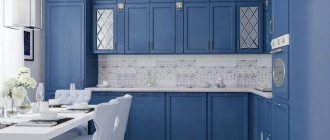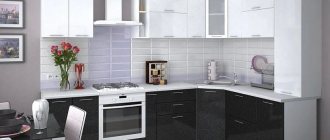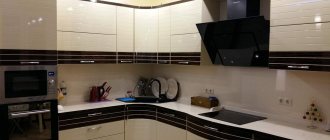Olive cuisine is a universal combination. Anyone can create a unique design with its help: from an amateur to a professional. A few basic rules - and an impressive result is guaranteed.
Olive is a classic for the kitchen interior. This color is otherwise called “gentle khaki”. Depending on the tonality, it allows you to create interesting and aesthetic combinations.
Peculiarities.
- Color base. Olive is a muted shade of green with the addition of yellowish and khaki tones. This allows you to use it as the basis of a palette with any basic shades.
- Versatility. Depending on the additional colors, it can be used to achieve any mood in the kitchen: from warm and joyful to calm and melancholic.
- A proven classic. Olive in kitchen design is a time-tested option. Many ready-made solutions and projects have been created with this color.
- Ease of use. Even a non-professional will be able to implement real masterpieces of design in their kitchen. The color is easy to apply. It's hard to go wrong with him.
- Compatibility. Olive, along with black and white, is an ideal base for any shade. This is a unique color. It harmonizes with all shades.
The main feature is the naturalness of olive. The combination of mustard tones and muted green gives a feeling of closeness to nature and creates a peaceful mood.
It can be used in two versions. First: olive - basic, occupies 60-70% of the color space. Second: olive acts as an additional color.
Repair and finishing
The olive kitchen set itself is an accent and suggests a neutral decorative surface finish.
White, beige, gray and their shades are considered suitable for walls. In large kitchens, it is acceptable to use dark gray wallpaper (graphite, wet asphalt) and even black paint.
For the floor, first choose easy-to-care materials (laminate, linoleum, quartz vinyl, tile). The first three can be imitation natural wood of medium saturation. Tile and PVC tiles are preferably plain or with the texture of concrete (if a combination with gray is chosen).
The ceiling is made white as standard. In small kitchens, a glossy stretcher will look best.
The last question is the apron. The main options for olive kitchen in the interior:
- White. Matte or glossy skins, a classic hog, exclusive white marble - any will look appropriate.
- Black. It is realized using glass, suitable tiles, MDF panels with chalkboard patterns.
- Brown. For example, in the same tone with a wooden tabletop. In stores you can find aprons and tabletops of the same color.
The photo shows a muted shade of olive
Apron
An olive-colored kitchen can successfully “wear” either a calm monochromatic or a bright or even variegated apron. If you are going to make it olive, then let the shade be more intense than the main color of the furniture.
A contrasting apron will look great. But, to create a complete composition, it needs to be supported with additional accessories to match.
If you decide to lay out your kitchen apron from ceramic tiles without a pattern, then a bright, possibly contrasting, grout for the seams will help give it more individuality and expressiveness.
A tile with an image of olive branches can support the theme of the southern coast.
What color of furniture and appliances is suitable?
Olive does not set clear parameters for choosing a technique: it all depends on your personal preferences and the chosen style.
In a corner kitchen in Provence or classic style, beige stoves and ovens in retro design and dome hoods are appropriate.
High-tech prefers minimalist black or chrome options; in Scandi, all-white equipment is acceptable.
The photo shows green furniture with black handles and a wooden tabletop
Successful color combinations
It is wonderful that olive promotes calm and tranquility when it comes to muted shades. But if you don’t take care of a harmonious combination with other colors, you can go to extremes - your family will literally fall asleep in the kitchen.
That is why they usually do not make the entire environment monochromatic. You can and should play with different colors. If you want to create a neutral interior, the best choice would be chocolate or coffee, cream or beige colors. They will enliven the space, harmonize it, without crowding out the feeling of calm and comfort.
However, if desired, it is worth adding expressive, juicy natural colors to the kitchen - ripe raspberries, refreshing and invigorating orange. It will be an organic composition where each element balances each other. Olive no longer looks too boring, and raspberry and orange colors will not irritate.
If you want to experiment even more boldly, then try adding strokes of tones such as fuchsia, turquoise, and aquamarine. Naturally, it is important to maintain balance so that the kitchen does not turn out tacky. Therefore, such colors should be present as minor accents.
By the way, the white color emphasizes the beauty of the olive very interestingly. It gives a feeling of freedom and purity. As a rule, when choosing proportions, they adhere to the following principle: the brighter the shade of olive, the more dazzling whiteness is needed in the kitchen.
Which countertop to choose?
Recommendations for choosing a table for a work area are the same as for an apron. Most often, white and black plain surfaces with imitation stone are used. In country and other styles that require home comfort and warmth, a light wooden texture would be appropriate.
Gray colors will add rigor and are suitable for both classic and minimalist modern solutions.
Spectacular proximity to a tree
Born from nature, olive color goes perfectly with wood. For example, it is possible and necessary to make such floors, naturally, selecting a species that will withstand special operating conditions. After all, liquids are spilled in the kitchen, heavy metal and sharp objects can fall.
In general, it is possible and necessary to add various objects with imitation wood to the interior. This is a very good neighborhood. It's great if you buy a classic wooden dining table and chairs for it. Of course, the style of the interior must also be taken into account. For example, high-tech and minimalism are played by different rules.
But in loft, baroque, classicism, wood and olive are an ideal combination. At the same time, the natural material is preserved in its natural color. Even the gloss of a varnished surface can spoil the impression.
What curtains are suitable?
Curtains and other textiles (tablecloths, towels) are relatively easy to replace, so here you can allow yourself to experiment and try something bright. Sunny yellow or crimson red perfectly tone up and lift your spirits.
Don't want rich accents? Light colors look great against an olive background: white, beige, gray. To prevent the curtains from being conspicuous, try to choose a fabric that matches the color of the walls.
Olive details
Olive in kitchen details creates smoothness and well dilutes neutral colors: beige, white or gray. Gray-olive cuisine is suitable for lovers of calm and meditative eating.
A cream or white kitchen with green elements will create a feeling of luxury and wealth, and will also remind you of Mediterranean countries.
The main colors of the kitchen can be easily diluted with light green details:
- Stucco molding on the facade of the kitchen
- Open hanging shelves
- Cushions on chairs
- Blanket on the sofa
- Mats for plates
- Vases and other utensils
- Curtains
Important! Olive for details you need to select bright, light shades. Dark options will be lost against the background of other colors and create a feeling of dirtiness.
Which decor to choose?
The best decorations in kitchens of any style are functional. Beautiful dishes on open shelves, for example, will help create the right atmosphere: cute porcelain teapots with flowers for French chic, neat wicker baskets or wooden figured boards for Scandi.
The photo shows a bright apron with oriental patterns
Lamps in an olive-colored room not only perform the main function, but also decorate the space: just instead of standard spots, you should choose original pendants and complement them with wall sconces.
Textile
Imagine the most fashionable, stylish and modern kitchen without curtains, beautiful tea towels, oven mitts and other fabric items. Will it be cozy in such a kitchen? Of course not.
Beautiful curtains for the kitchen not only protect us from the bright sun and participate in the overall multi-colored design idea, but also create a cozy atmosphere, and sometimes can completely change the look of the room. Therefore, choosing original textiles is perhaps the most important thing after choosing furniture.
A set of white textiles will look very festive and bright in a warm olive interior: airy curtains, stylish tablecloth and napkins, original oven mitts and towels.
But, curtains can also serve as an independent contrasting color accent, complemented by small decorative details. Curtains of chocolate, mustard, cream or blueberry color go well with the color of olives.
What style should you decorate your kitchen in?
Real examples of the use of olive color show that the choice of style is absolutely unlimited, just furniture and accessories will be different in different designs.
For example, Provence is distinguished by a combination with beige, carved facades, textiles with floral patterns and a love of wood.
A modern interior in olive color prefers glossy facades without handles, white or black countertops, aprons, and trim.
Don't be afraid of green in the interior, especially in the kitchen! With its help you will create a unique and cozy interior that promotes rest and relaxation.
Olive as the main one
Olive is perfect for decorating the following kitchen details:
- Facade set
- Worktop
- Chairs and sofa
- Curtain
- Carpet or tiles in the kitchen
- Kitchen apron
Important! You should not use the same color for all large kitchen details. It is better to choose a combination of olive and some other color.
The combination of different shades of this color looks picturesque. For greater comfort, it is better to choose dark olive tones for the design of the lower parts: floor tiles, cabinet fronts, carpet for the dining area and chairs.
And for elements that are located higher, it would be more appropriate to use light colors: for curtains, wallpaper and the facades of wall cabinets.
Rules for working with the interior
If you are determined to play with olive color when renovating your kitchen, you must adhere to the basic rules for its use. Firstly, its cold shades do not combine well with the warm tones of other colors, and vice versa.
To visually expand the space, it is worth adding white to the kitchen interior, or at least beige. But dark colors visually make the room smaller.
Finally, it is worth knowing about the proper combination of olive with the materials used in the decoration of the kitchen. The more metal and glass, the colder the tone should be, and with wood, matte ceramic tiles, and wallpaper, warm shades look better.
There are different attitudes towards this color - some people idolize it, while others don’t like it. True, a lot depends on the shade - both a delicate shade of khaki and bright, rich tones are called olive. In any case, such colors are welcome in the kitchen. Psychologists claim that they act in a calming, peaceful way. Designers talk about the nobility and elegance of the interior with olive notes. Housewives like that such shades do not irritate.
Successful color combinations
It is wonderful that olive promotes calm and tranquility when it comes to muted shades. But if you don’t take care of a harmonious combination with other colors, you can go to extremes - your family will literally fall asleep in the kitchen.
That is why they usually do not make the entire environment monochromatic. You can and should play with different colors. If you want to create a neutral interior, the best choice would be chocolate or coffee, cream or beige colors. They will enliven the space, harmonize it, without crowding out the feeling of calm and comfort.
However, if desired, it is worth adding expressive, juicy natural colors to the kitchen - ripe raspberries, refreshing and invigorating orange. It will be an organic composition where each element balances each other. Olive no longer looks too boring, and raspberry and orange colors will not irritate.
If you want to experiment even more boldly, then try adding strokes of tones such as fuchsia, turquoise, and aquamarine. Naturally, it is important to maintain balance so that the kitchen does not turn out tacky. Therefore, such colors should be present as minor accents.
By the way, the white color emphasizes the beauty of the olive very interestingly. It gives a feeling of freedom and purity. As a rule, when choosing proportions, they adhere to the following principle: the brighter the shade of olive, the more dazzling whiteness is needed in the kitchen.
Spectacular proximity to a tree
Born from nature, olive color goes perfectly with wood. For example, it is possible and necessary to make such floors, naturally, selecting a species that will withstand special operating conditions. After all, liquids are spilled in the kitchen, heavy metal and sharp objects can fall.
In general, it is possible and necessary to add various objects with imitation wood to the interior. This is a very good neighborhood. It's great if you buy a classic wooden dining table and chairs for it. Of course, the style of the interior must also be taken into account. For example, high-tech and minimalism are played by different rules.
But in loft, baroque, classicism, wood and olive are an ideal combination. At the same time, the natural material is preserved in its natural color. Even the gloss of a varnished surface can spoil the impression.











